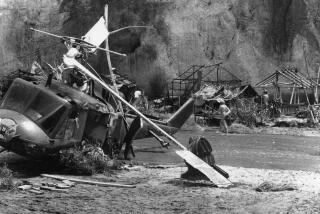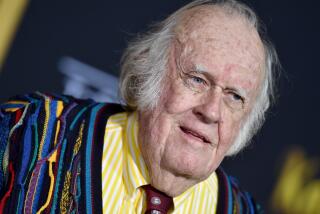Real-Life Killings in the Reel World of Hollywood : Publishing: New book contains all the ingredients of an intriguing drama--wealth, con games, movies and murder.
Jon Emr’s flamboyant life, and the violent death he met on a Culver City street were just the type of intriguing drama Emr might have used to make a buck.
Accused of conning rich investors dazzled by the chance to play movie mogul, Emr was sued by at least four people who claimed he took their money never intending to make any films, according to a book by Rod Lurie published this month by Pantheon.
A man who presented himself as a Hollywood producer of hundreds of films, Emr had only one small-time television credit.
But Emr’s false promises caught up to him on the corner of Slauson Avenue and Sepulveda Boulevard on July 11, 1991. As Emr sat in the front seat of a rented Lincoln Town Car, a man Emr had promised to make a Hollywood producer emptied a .22-caliber revolver into the car, killing Emr and his 19-year-old son, Roger Emr.
The next day, Culver City Police Sgt. Hank Davies discovered that Jon Emr’s father, Art Emr Sr., 71, had been killed on June 10. And the gunman’s ex-girlfriend, a 28-year-old cocktail waitress, was missing.
“This was probably the biggest case we ever had,” said Davies, of the murder that is featured in “Once Upon a Time in Hollywood: Movie Making, Con Games and Murder in Glitter City.”
The book focuses on Emr’s success in convincing investors to hand over thousands of dollars by making them believe he was a movie producer. Based on legal papers and interviews with police and Emr’s victims, author Lurie tells how Emr was able to use the allure of Hollywood to outmaneuver otherwise business-savvy people.
“It’s amazing . . . how gullible people will be when Hollywood is concerned,” said Lurie, a film critic for Los Angeles Magazine. “It’s not just the money issue. It’s fame, it’s celebrity, it’s skiing with [movie stars] in Aspen.”
But those doing business with the heavy-drinking, Hawaiian-shirt-wearing Emr eventually caught on.
“There were quite a few people I talked to who would tell me stories about being conned, or believing they were conned into giving their money away,” said Davies, who had just been assigned to head Culver City’s homicide unit four days before the slayings.
During Davies’ investigation, he said, he got numerous calls from people who knew Emr, pointing out enemies who might have wanted him killed. Some even cheered Emr’s death.
But the Emr slaying was not a whodunit for police. Emr’s mother, Renee Emr, was riding in the Lincoln’s back seat when Emr was shot and identified Robert Michael Allen as the gunman. Emr had hired Allen as a bodyguard nine months before the shooting, and had promised him $30,000 and a role as associate producer on a movie biography of actor James Dean.
When Allen, a failed private investigator with a shady past and cruel streak, realized Emr never meant to pay him, he cracked, according to the book. Unlike Emr’s other targets, Allen had little money to lose. While waiting for Emr to make good on his promises, Allen was evicted from his apartment and his girlfriend abandoned him.
“He placed all of this on Emr and he felt there was nothing else to live for anymore and wanted to take everyone else with him,” Davies said. “I think Allen really blamed Jon Emr for his total downfall.”
After Emr and his son were killed, Allen disappeared. Davies appeared on national crime shows to appeal for help finding the fugitive, who was listed on the FBI’s Ten Most Wanted List.
Police believe Allen killed his ex-girlfriend, Susan Lynn Calkins, and her dog over the weekend of July 4, 1991--a week before he shot Emr--and buried both in a shallow grave about 20 miles north of Twentynine Palms in San Bernardino County.
Then, according to police, Allen drove to Emr’s father’s house in a suburb of Phoenix, looking to kill Emr’s two teen-age sons. But finding only Art Emr Sr. at home, Allen instead killed the elder man by shooting him five times in the head.
Allen told a friend that Emr was responsible for his breakup with Calkins. “Allen blamed Emr for Susan Calkins’ death even though he actually killed her,” Davies said. “And he wanted Emr to feel that same loss that he was now feeling.”
Allen then returned to Emr’s rented Culver City office space, followed him to a stoplight, then shot him and Roger. A few days later Allen spent the day at Disneyland with a friend, then returned to where he had buried Calkins and committed suicide, police said.
Allen’s remains were found scattered alongside Calkins’ sun-bleached bones in the desert in December, 1992.
Such a grisly murder tale would have made a true-crime book an easy sell, but Lurie sees the Emr-Allen saga as more of a cautionary tale about Hollywood. After all, Lurie contends, it was Allen’s desire to be part of the movie industry that led him to Emr despite warnings from others that Emr was a con man.
“The story is about the bear trap of Hollywood and how people’s minds become instantly lobotomized with the hope of the Hollywood dream,” said Lurie, who spent three years researching and writing the book.
But Lurie’s association with the story of Jon Emr is far from over. An aspiring filmmaker himself, Lurie has been bitten by the Hollywood bug. He recently optioned the film rights to the book to director Bud Yorkin (“The Thief Who Came to Dinner”) and was hired to write the script.
“I am convinced we are going to go the full way” with the film, Lurie said. “This is too good a story.”
More to Read
Sign up for our Book Club newsletter
Get the latest news, events and more from the Los Angeles Times Book Club, and help us get L.A. reading and talking.
You may occasionally receive promotional content from the Los Angeles Times.






